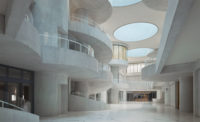Tokyo
Meiji is Japan's largest chocolate manufacturer, and its 100% Chocolate Café, designed by the Tokyo-based firm Wonderwall, is a cocoa connoisseur's dream come true. In addition to dominating the menu, Meiji's mainstay is the defining element of the café's architecture. A transparent refrigerator showcasing tubs of chocolate greets patrons upon entry; walls of wrapped chocolate squares tile the sales section; and an open kitchen, where chocolate concoctions are prepared before customers' eyes, presides over the seating area. Most delectable of all, a spectacular suspended ceiling that replicates Meiji's iconic itachoco bar in wood covers the room with chocolate.
Opened in May 2012, the café is Meiji's second foray into retail. The first came about in 2004 when the company rebuilt its headquarters in the heart of downtown Tokyo. Going head-to-head with the luxury chocolatiers launching boutiques citywide, Meiji hired Wonderwall to create a street-level shop in its new building. According to Hiroshi Harada, manager of Meiji's Business Development Team, the combined shop and café, based on the idea of a “chef's table in the kitchen,” establishes direct contact between the mass-market manufacturer and its customers, minus the prices of the high-end brands.
The immediate success of the flagship inspired thoughts of a second outlet—but only if the company could find an appropriate venue. That opportunity arose with the construction of Tokyo Skytree, a 2,080-foot-high broadcast tower looming over a low-scale neighborhood east of the Sumida River. The building was poised to make its mark on the city's skyline and become a hot tourist spot. To lure visitors, the developers built Tokyo Solamachi, a 312-store mall, at the tower's base. When a 1,956-square-foot space with direct outdoor access became available, Meiji moved forward with its plan. “It is not just a shop inside a mall,” explains Wonderwall founder Masamichi Katayama. With two exterior exposures, one directly opposite Skytree's elevator lobby, the café is practically an independent entity.
Incorporating the building's window walls as mandated by the developer, Katayama put a take-out counter and the shop's main entrance on Skytree's front, pedestrian plaza. (A secondary door at the back of the store connects to the mall interior.) He organized the café itself into three different seating areas with a central, open kitchen that separates it from a retail section behind. Then he installed another, concealed kitchen, connected to the first by a pass-through, where ingredients are prepared from scratch daily. This area mediates the café's rectilinear layout and the irregular geometry of the raw space.
Though the base building's 16-foot-high gross ceiling height offered plenty of design opportunities, the four reinforced-concrete columns at the perimeter could not be budged. To diminish their presence, the designer covered both the 33-inch-square columns and the adjacent walls with white, 4-inch-square glazed tiles normally used in home kitchens. Wood floors, stainless steel counters and cabinets, and the “skeleton refrigerator” underscore Katayama's “open kitchen” concept.
One of the project's signature elements, the full-height glass case chills 56 individual bins of chocolate, each a different flavor developed by the client. Parlaying an architectural detail into a successful marketing tool, the vats, which are identified by name and number, correspond to the chocolates for sale. Their bright, candy-colored wrappers, along with the café's logo, are the products of the graphic-design studio Groovisions.
While the retail side caters to Japan's voracious appetite for souvenir shopping, the seating area, with its chocolate-brown Tolix chairs, accommodates groups of various sizes. In addition to the seven-person stainless steel bar at the window facing Skytree, 32-inch-round white marble tables fit groups of four, and a 19-foot-long communal gray-veined slab, running parallel to the kitchen, seats up to 20. Invisible wood underpinnings support the heavy top from below and secure a row of glass-shaded lamps affixed to the tabletop that softly illuminate and separate strangers sitting opposite each other.
Elsewhere, rows of decorative pendants—simple globes above the counter seating and vintage-inspired fixtures above the kitchen—contribute to the cheery atmosphere. Thanks to the glass facade, the room is filled with daylight, augmented by halogen downlights mounted in the ceiling—the only surface where Katayama could really go to town.
A thick slab of mouth-watering walnut wood articulated with a chunky, chocolate-bar-like grid, the nearly foot-deep dropped ceiling unifies the café. It also conceals the mechanical and electrical equipment, such as fire-protection, lighting, and air-conditioning systems (the on-site chocolate preparation prohibits room temperatures above 75 degrees Fahrenheit); and, although the indirect fluorescent lighting around the ceiling structure makes the suspended plane appear to be floating, it requires a steel-box frame to hold its heavy construction in place.
“The ceiling is a little 'pop,' ” concedes Katayama with a grin. One would not expect anything less from Wonderwall, but this isn't Hello Kitty kitsch. The 100% Chocolate Café at Skytree tastefully creates a new consumer outlet without challenging the image of the established chocolate manufacturer.
Naomi R. Pollock is a Tokyo-based architect and special international correspondent for RECORD.
Cost: withheld
Completion Date: May, 2012
Gross Square Footage: 1,956 sq. ft.
People
Owner:
Interior designer:
Consultant(s):
General contractor:
Photographer(s):
CAD system, project management, or other software used:
Other: |
Products
Interior finishes
Special interior finishes unique to this project: Chocolate bar ceiling: sliced veneer walnut color dye Kitchen Counter: stainless steel
Furnishings
Tables: Big table/round table: Marble
Lighting ROMEO MOON T1 Table Lamp by Flos
Downlights:
For the indirect lights used around the chocolate bar ceiling:
For the lights along the facade: Kitchen counter pendant lights: cast aluminum street lights/Complex Universal Furniture Supply |









